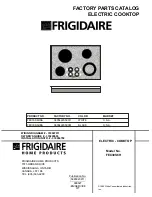
17
Appropriate flare union adapters are required
at each end of the flexible connector.
Turn on the gas; check for leaks using a
liquid leak detector at all joints in the system
(the pressure test nipple is adjacent to the gas
inlet pipe on the rear right hand side of the
cooktop bottom).
CAUTION: DO NOT USE A FLAME
TO CHECK FOR GAS LEAKS.
IMPORTANT–Disconnect the cooktop and the
individual shut-off valve from the gas supply
piping system during any pressure testing of that
system at test pressures greater than 1/2 psig.
Isolate the cooktop from the gas supply piping
system by closing the individual manual shut-off
valve to the cooktop during any pressure testing
of the gas supply piping system at test pressures
equal to or less than 1/2 psig.
STEP 9
INSTALL THE DUCTWORK
Use minimum 26 gauge galvanized or 24 gauge
aluminum duct in 6
″
round or 3
1
⁄
4
″
x 10
″
size, or
a combination of both. PVC duct should be used
if installing under a poured concrete slab. DO
NOT use flexible ducting.
Always use an
appropriate roof
or wall cap with
damper.
Laundry type
wall caps should
never be used.
Use the
straightest duct
run possible.
For satisfactory performance the duct run
should not exceed 75 ft. or its equivalent length if
bends or other various fittings are used. Refer to
table of equivalent lengths for various duct
configurations.
Install ductwork so that the piece of duct nearest
the downdraft unit slots INTO the next piece of
duct. Secure all joints with self tapping screws
and apply duct tape around the joint to ensure an
airtight seal.
STEP 7
(continued)
INSTALLING THE COOKTOP
NOTE: If the cooktop is installed in a 36 inch
base cabinet, the mounting brackets cannot be
used because of the interference with the sides
of the cabinet. In this case, the cooktop can be
secured to the sides of the cabinet using angle
brackets (not supplied). Remove one screw at
the bottom of the cooktop body, on each side,
then replace to hold the bracket to the cooktop.
Then secure the brackets to the cabinet sides
with the screws provided.
Connect the 9-pin plastic plug from the downdraft
unit to the 9-pin plastic socket situated adjacent
to the power cord on the cooktop. Secure the
metal cover in position over the connection.
Layout of service panel
STEP 8
GAS CONNECTION
Install the supplied pressure
regulator and nipple in the gas
line as close to the cooktop inlet
as possible, making allowances for
ventilation ducting as necessary.
Make sure the regulator is
installed in the right direction.
Install a manual shut-off valve in
the gas line in an easily accessible
location, as close to the pipe stub
as possible, making allowances for
the ventilation ducting. Be sure
you know how and where to shut
off the gas supply to the cooktop.
NOTE: Instead of using solid
piping to connect to pressure
regulator, an approved flexible
metal appliance connector may be
used between the pipe stub and
shut-off valve and the pressure
regulator, if local codes permit.
Duct tape over
seam and screws
Air flow
Screw
Pressure
regulator
Pressure
test point
9-pin socket
Metal cover
9-pin
plug
Electrical
supply cord
Service
plate
(continued next page)












































